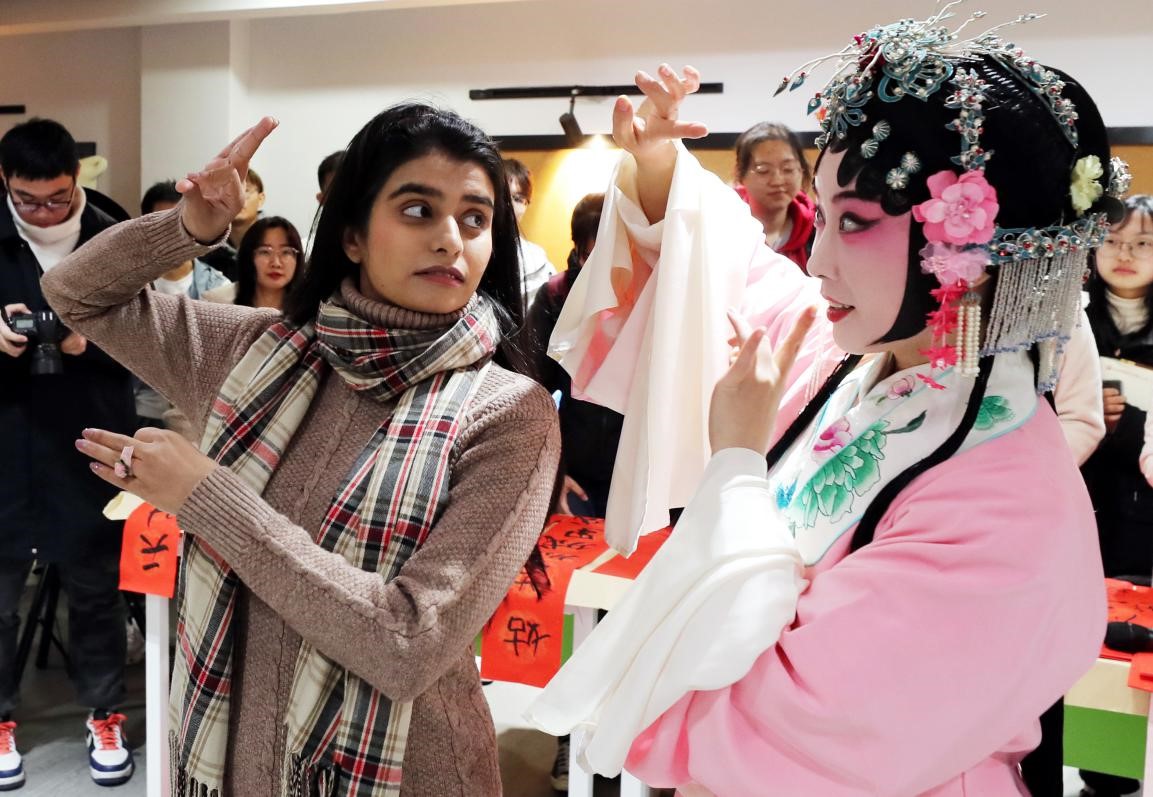

 |
| Photo shows a Pakistani student of the College of Textile and Clothing Engineering of Soochow University in Suzhou, east China’s Jiangsu province, learning Kunqu Opera from Kunqu actress Lyu Jia, Dec. 21, 2020. (People’s Daily Online/Hua Xuegen) |
Not long ago, two new intangible cultural heritage items from China were inscribed on the United Nations Educational, Scientific and Cultural Organization (UNESCO) Representative List of Intangible Cultural Heritage of Humanity, making the country top the list with 42 items.
The newly enshrined items are Taijiquan, a kind of traditional martial arts, and “Wangchuan ceremony and related practices for maintaining the sustainable connection between man and the ocean,” which was nominated by China together with Malaysia. Both items have a history of several centuries in China.
Taijiquan’s relaxed, circular, gentle and flexible movements, the traditional concepts reflected in the movements of Taijiquan, including the cycle of Yin and Yang, the two opposing principles in nature, and the theory that “man is an integral part of nature”, as well as the standing posture featuring straightness of the body demonstrate the unique characteristics of gentleness, inclusiveness, and strength in Chinese culture.
As a vivid example of respecting lives and revering nature, the Wangchuan ceremony has also witnessed the spread of Chinese culture in countries along the Maritime Silk Road.
As the two items containing the “genes” of Chinese culture have been recognized as world-class intangible cultural heritage, they will surely enhance Chinese people’s confidence in their culture, and open the door to the unique concepts, wisdom, and charm of Chinese culture wider for the rest of the world.
In recent years, a multitude of Chinese intangible cultural heritage items have been acknowledged by the UNESCO, such as Kunqu Opera, Peking Opera, the Dragon Boat Festival, Zhusuan, also known as Chinese abacus, acupuncture of Traditional Chinese Medicine, and the 24 solar terms.
It signifies that the values deeply rooted in China and the traditional Chinese wisdom based on several thousand years of history are increasingly recognized and respected by the international community, and that China’s unique cultural resources and spiritual pursuits are making new contributions to the building of common values of humanity.
In fact, besides intangible cultural heritage, other achievements made in China’s cultural sector have also attracted global attention in recent years. Cultural activities on Chinese festivals have been held all over the world; Chinese film and television works have won a great number of overseas followers; and the export of online works of Chinese literature has become global cultural phenomenon.
China’s achievements in bidding for the UNESCO intangible cultural heritage list have shown the recognition Chinese culture has gained worldwide as well as the country’s commitment to ensure the inheriting of fine traditional culture.
The traditional Li textile techniques of spinning, dyeing, weaving and embroidering of China, which is now an item on the UNESCO List of Intangible Cultural Heritage in Need of Urgent Safeguarding, was in imminent danger of extinction when China decided to nominate it as intangible cultural heritage over a decade ago. At that time, the centuries-old techniques had less than one thousand inheritors.
After it was officially inscribed on the UNESCO intangible cultural heritage list, China has put into action its promise to protect the traditional techniques and mobilized various social forces in facilitating the inheriting of the techniques, eventually revitalizing the precious intangible cultural heritage.
Successful entry into the UNESCO intangible cultural heritage list is not the destination, but a new starting point for the inheriting and protection of cultural heritage.
Only by constantly improving its capability to protect intangible cultural heritage and effectively addressing problems troubling the protection and development of various intangible cultural heritage items, can China comprehensively raise public awareness of intangible cultural heritage and help it shine more brightly in the world.
The number of items of intangible cultural heritage jointly nominated by countries hit a new high in the year 2020, according to a press communiqué released by the UNESCO.
Culture has served as the bridge between hearts and brought countries separated by mountains and rivers closer to each other.
Although the COVID-19 pandemic has prevented people from gathering, cultures and intangible cultural heritage have linked people around the world closer with each other, said an official of the UNESCO.
The popularity of Taijiquan in foreign countries and the role of the Wangchuan ceremony in enhancing people-to-people bonds have both proven the importance of making the protection of the world’s intangible cultural heritage a common goal of mankind and intensifying cultural exchanges, mutual learning, and understanding between peoples of various countries around the world while jointly advancing the protection of culture.
Only in this way can countries better draw wisdom and strength from different civilizations, and provide spiritual support and comfort for people in tackling various challenges confronting mankind.
 |

 Award-winning photos show poverty reduction achievements in NE China's Jilin province
Award-winning photos show poverty reduction achievements in NE China's Jilin province People dance to greet advent of New Year in Ameiqituo Town, Guizhou
People dance to greet advent of New Year in Ameiqituo Town, Guizhou Fire brigade in Shanghai holds group wedding
Fire brigade in Shanghai holds group wedding Tourists enjoy ice sculptures in Datan Town, north China
Tourists enjoy ice sculptures in Datan Town, north China Sunset scenery of Dayan Pagoda in Xi'an
Sunset scenery of Dayan Pagoda in Xi'an Tourists have fun at scenic spot in Nanlong Town, NW China
Tourists have fun at scenic spot in Nanlong Town, NW China Harbin attracts tourists by making best use of ice in winter
Harbin attracts tourists by making best use of ice in winter In pics: FIS Alpine Ski Women's World Cup Slalom
In pics: FIS Alpine Ski Women's World Cup Slalom Black-necked cranes rest at reservoir in Lhunzhub County, Lhasa
Black-necked cranes rest at reservoir in Lhunzhub County, Lhasa China's FAST telescope will be available to foreign scientists in April
China's FAST telescope will be available to foreign scientists in April